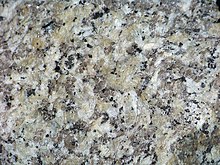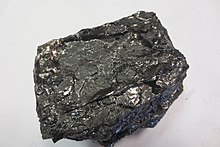Rock of the year
Rock of the Year is an award that has been presented by the Professional Association of German Geoscientists (BDG) since 2007 , initially together with the German Society for Geosciences (DGG). The award is made based on a proposal by the "Board of Trustees of the Year", which includes representatives of the BDG as well as experts from geological state offices , the Federal Institute for Geosciences and Raw Materials , from geotourism and the raw material and natural stone industry ( Federal Association of Mineral Raw Materials , MIRO). The aim is to present rocks to the public both in terms of their geological origin and their use in business and society - as well as geology and geosciences as a whole - mainly through thematic events and publications.
The rocks are divided into three large groups (classes) according to their formation: igneous rocks (solidification rocks ; arise from the crystallization of a rock melt), sedimentary rocks (sedimentary rocks; arise from the deposition and compression of weathered and redistributed material) and metamorphic rocks (transformation rocks ; arise by conversion from other rocks by high pressure and / or high temperature). For the rock of the year, care is taken to ensure that the three rock classes are equally represented.
Since summer 2018 the board of trustees has consisted of the following members: Werner Pälchen (Halsbrücke), Manuel Lapp (Saxon State Office for Environment, Agriculture and Geology , Freiberg), Angela Ehling ( Federal Institute for Geosciences and Natural Resources (BGR), Berlin), Peter Müller ( Professional Association of German Geoscientists (BDG), Bonn), Tamara Fahry-Seelig (Professional Association of German Geoscientists (BDG), Berlin), Gabriela Schulz, Federal Association of Mineral Raw Materials (MIRO), Andreas Günther-Plönes (BDG, natural stone industry), Christof Ellger ( GeoUnion Alfred Wegener Foundation , Potsdam), Ina Pustal ( Thuringian State Office for Environment, Mining and Nature Conservation ). Manuel Lapp has been the spokesman for the Board of Trustees since June 28, 2018.
In 2013, kaolin was the first unconsolidated rock of the year.
| year | rock | Illustration |
|---|---|---|
| 2007 | granite | |
| 2008 | Sandstone | |
| 2009 | basalt | |
| 2010 | limestone | |
| 2011 | tuff | |
| 2012 | Quartzite | |
| 2013 | kaolin | |
| 2014 | Phonolite | |
| 2015 | Gneiss | |
| 2016 | sand | |
| 2017 | Diabase | |
| 2018 | Hard coal | |
| 2019 | slate | |
| 2020 | Andesite |














